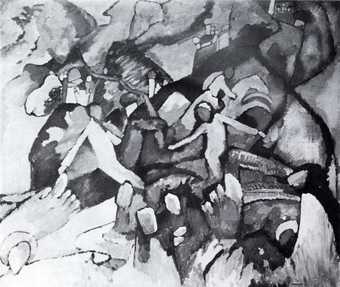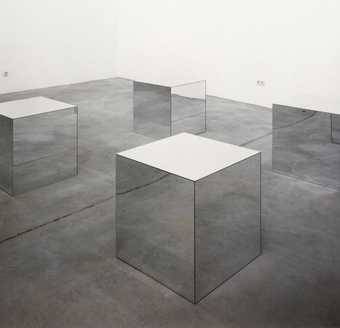How do we remember exhibitions and how do exhibitions remember themselves? These questions are key to an understanding of postmodernist exhibition practices and the emergence of what I would argue is a new exhibition genre. I call it the ‘remembering exhibition’, and use the term for exhibitions that remember past exhibitions. I employ the gerundive here deliberately because it is ambiguous, confounding subjective and objective acts of memory and suggesting an oscillation between the two.
My subtitle, ‘From Point to Line to Web,’ is a riff on Wassily Kandinsky’s Point and Line to Plane.1 With it, I want to invoke a technological-historical progression, as well as a conceptual paradigm shift, for ‘remembering exhibitions’. We think of exhibitions as moments in time – isolated points – and refer to extraordinary exhibitions as stations or landmarks – spatio-temporal points, implying a journey where an historical path or line paused and was re-routed.
The web allows us to reconsider the developmental or progressive models used for histories of exhibitions. With it, we can begin to position exhibitions in and as an expanded field (to use Rosalind Krauss’s phrase) where the single example or implied line is but one possibility for recalling exhibitions and constructing exhibition histories.2 Instead of an episodic history, the web and its tools can foster interwoven historical perspectives, layered approaches, and a myriad of interconnections. The shift can be characterised as moving from two to multiple dimensions, from a typographic to a topographic representation of history, from fixed to fluid constructs.3 Even if the web functions merely as an online archive recording more information and more exhibitions, there is the real possibility of different and more decentred histories emerging, histories that call the very concept of a landmark exhibition into question.
The increasing number of exhibitions that remember past exhibitions attests to the importance of the exhibition phenomenon in today’s societies and points to a growing interest in the history of exhibitions, collective exhibition memory, and intersections of past exhibition theory and practice with contemporary concerns. The emergence of the ‘remembering exhibition’ is a manifestation of Western culture’s current fascination with memory as a modality for constructing individual or collective identities. How we remember exhibitions and our need to remember them are very much part of recent exhibition culture. ‘Remembering exhibitions’ also attest to a belief in a dynamic, rhizome-like notion of history where past and present are interwoven. As such, ‘remembering exhibitions’ belong to the practice of spatialising memory, making memory concrete, tangible, actual and interactive. ‘Remembering exhibitions’ can be discursive events, dynamic cultural moments of active, widespread exchange and debate that in turn are catalysts for changing perceptions and practices.4 They have the potential for altering past and future views of the exhibition condition.
What we remember is often determined by how we remember. In this essay, I shall focus on three memory structures for ‘remembering exhibitions’ – the replica, the riff, and the reprise. They range from materialised memory to memory morph and to immaterial memory referent; from haptic re-enactment to the manipulated and manipulable manifestation; from exhibitions within exhibitions to exhibitions about exhibitions to exhibitions re-presented online. All co-exist temporally and sometimes overlap, yet each of these modes acknowledges and activates different types of memories, and, I would argue, different histories and different types of histories.
The ‘remembering exhibition’ as replica
The most common form of ‘remembering exhibition’ is the replica. This approach seeks to re-assemble as much of the artwork displayed as possible, either as originals or reproductions, in a stand-alone single exhibition or sequence of exhibitions that may or may not employ the initial installation schema and may or may not be held in the original location. In what I term a ‘repeat remembering exhibition’, all the original contents of an earlier exhibition are re-assembled in the same, unchanged space in the same arrangement as before.5 In most replica exhibitions, however, there is some deviation from the original, and the art is often supplemented by archival documentation ranging from exhibition photographs to documents relating to the show’s reception. Usually, these exhibitions are large-scale homage or anniversary exhibitions, designed to isolate an important moment in art history, to promote research, and to underscore the singularity of a given exhibition. This was the case, for example, with the 1992–3 Gutai Exhibition 1–2–3 at the Ashiya City Museum of Art and History which reconstituted, as far as possible, the Gutai exhibitions that took place inAshiyaPark in the mid 1950s. Many of the original artworks were exhibited in three sequential exhibitions in the museum; others were re-created for an exhibition in the park during the period of the exhibition in the museum.6
More recently, Robert Morris’s bodyspacemotionthings was recreated at Tate Modern as part of the 2009 UBS Openings: The Long Weekend. Morris’s 1971 Tate exhibition closed after five days because the interactions invited by the works were deemed too dangerous. The replica works, adjusted for safety, constituted a public remembering of a moment in the museum’s history and a testimony to the changes in both individual and institutional responses to participatory exhibitions. 7
The event was widely publicised with period photographs in the London press in the lead-up to the festival weekend, ensuring that the two versions of the exhibition were inscribed in both past and recent histories of Morris and Tate.
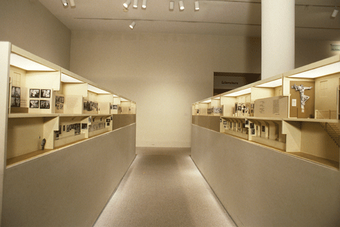
Fig.1
Installation view showing the reconstruction of the 1937 Entartete Kunst exhibition in Degenerate Art: The Fate of the Avant-Garde in Germany, 1991, Los Angeles County Museum of Art
Los Angeles CA, Los Angeles County Museum of Art (LACMA)
© 2009 Digital Image Museum Associates/LACMA/Art Resource NY/Scala, Florence
Some ‘remembering exhibitions’ are found within another, usually historical, exhibition. This mise en abyme device is designed to convey a broader sense of the period than that provided by the relevant artworks alone. It is most often used for exhibitions or exhibition spaces that revolutionised the norms of display. Two early examples are the inclusion of replica spaces of the 1937 Entartete Kunst [Degenerate Art] exhibition in curator Stephanie Barron’s 1991 Degenerate Art: The Fate of the Avant-Garde in Nazi Germany (fig.1) and her 1997 Exiles and Emigrés: The Flight of European Artists from Hitler which featured a replica space based on the iconic installation photographs of Frederic Kiesler’s New York Art of this Century gallery designed in 1942 for Peggy Guggenheim (fig.2).8
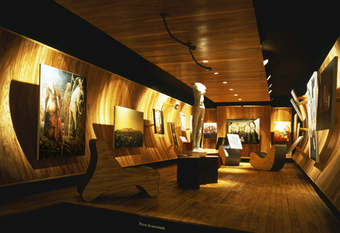
Fig.2
Reconstruction of Frederick Kiesler’s designs for Art of This Century, 1942, in Exiles and Emigrés: The Flight of European Artists from Hitler, Los Angeles County Museum of Art, 1997
Los Angeles CA, Los Angeles County Museum of Art (LACMA)
© 2009 Digital Image Museum Associates/LACMA/Art Resource NY/Scala, Florence
In both these examples the separation between past and present was manifested through technologies of vision and revision. Neither reconstruction was full scale nor entirely faithful to the disposition of the spaces of the original exhibitions. In 1937 the Entartete Kunst exhibition was shown in a number of rooms that changed dimensions and disposition as the exhibition travelled. By contrast, the 1991 reconstruction of Degenerate Art consisted of a free-standing corridor with a slightly raised floor in the middle of an exhibition gallery. Inside the corridor, the effect was that of entering a time tunnel for, unlike the rest of the 1991 exhibition, reproduced artworks were positioned in a crowded manner similar to the way they were encountered in 1937. The reduction of dimensions, the spatial compression and alterations, the whiteness of the reconstructed space and the inclusion of reproductions rather than originals were intended to convey the intensity of the experience of the 1937 exhibition without fetishising it.9
The reconstruction of Kiesler’s Art of this Century also utilised reproductions, but rather than walk through a corridor, visitors entered reduced-size versions of the original Art of This Century gallery spaces. The smaller scale and difference in display language compared with the rest of the Exiles and Emigrés exhibition made it seem as if one was stepping back in or out of time. Unlike the oppressive spaces of the Degenerate Art reconstruction, the effect of the darkened, strange, replicated galleries of the Art of This Century with their even stranger objects, and the intermittent and incongruous train whistle, was spectacular and wondrous. What a three-dimensional reconstruction can foster, then, is the possibility of experiencing the interplay between the aesthetics and the affect of earlier exhibition experiences, the look as well as the feel of past exhibitions.10
Such physical reconstructions recreate a sense of the spatial components of the original exhibition: the three-dimensionality of the exhibition halls; the spatiality of the artworks in relation to each other and the places in which they were exhibited; and the visitors’ spatial relationships, even if condensed or in somewhat altered form, with the historical exhibition environment and/or the art on display. Reconstructions provide a presence in real time that two-dimensional images, either still or moving, cannot convey. If three-dimensional exhibition reconstructions evoke the display trope of ‘period rooms’, they also conform to the recent shift from education to experience in many history and ethnographic museums where the aura of the original and opticality are replaced by a mind-body immersion in obviously fabricated recreations of past or unusual environments.11
By reconstructing the then novel, if not shocking, aspects of the Degenerate Art and Art of This Century installations, Barron created lieux de mémoire [sites of memory], tangible touchstones through which memory can be activated, recovered, and re-integrated into a collective memory of exhibitions.12 Her reconstructions prompted visitors to consider innovations in the presentation of art as integral to the history of art and the social and political history of an era. In other words, the genre of an exhibition within an exhibition encouraged visitors to consider an exhibition as a form in and of itself rather than a seemingly neutral, nodal medium for presenting individual artworks.
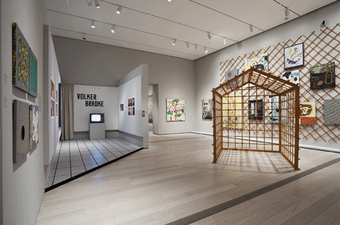
Fig.3
Reconstruction, at left, of Gerhardt Richter’s Volker Bradke exhibition at the Galerie Schmela, c.1966, in Art of the Two Germanys: Cold War Cultures, Los Angeles County Museum Art, 2009
Los Angeles CA, Los Angeles County Museum of Art (LACMA)
© 2009 Digital Image Museum Associates/LACMA/Art Resource NY/Scala, Florence
The replica ‘remembering exhibition’ has expanded to reference a number of different exhibitions within a single show. Art of Two Germanys/Cold War Cultures at the Los Angeles County Museum of Art, 2009, co-curated by Stephanie Barron, contained replicas of Heinz Mack’s c.1960 exhibition at the Galerie Diogenes, Berlin, and Gerhard Richter’s 1966 Volker Bradke exhibition at the Galerie Schmela (fig.3). Memory was materialised but entry was impossible, resulting in representations that were more visual than experiential. The artifice of the reconstructions – a free-standing wall on a dais and a room with walls of different heights and a raised floor, angled at the entrance – reduced the recreations to installations that bore a closer resemblance to complex, contemporary artworks or stage sets than to historical exhibitions (especially as the Richter was juxtaposed with Sigmar Polke’s 1967 similarly scaled, free-standing Potato House Object sculpture).13
Voids: A Retrospective at the Centre Georges Pompidou (23 February – 23 March 2009), the first exhibition inventory of exhibitions of totally empty spaces, was less an attempt to construct lieux de mémoire than places for contemplating an exhibition typology (fig.4). There was one room per empty exhibition by artists ranging from Yves Klein to Michael Asher and Maria Eichhorn, who used the void as their non-exhibition or anti-exhibition paradigm. None of the spaces were identical to the original rooms. Instead, what was replicated or recreated was the atmosphere of emptiness and the possibility of experiencing and thinking about voids as artworks and as exhibitions, then and now.14 The 2006–8 Allan Kaprow: Art as Life retrospective-presentation, where the artist’s environments and happenings were reinvented, functioned in a similar way: fidelity to past circumstances was less important than the construction of current experience.15
In these examples, multiple reconstructions as, or as part of, a single ‘remembering exhibition’ emphasise a practice rather than an event. Unlike the auratic aspects of single lieux de mémoire reconstructions, multiple reconstructions of non-spectacular exhibitions focus on different forms of engagement.
The ‘remembering exhibition’ as riff
Reconstructions, whether single or multiple, are not always possible. Michael Glasmeier, the curator of the 2005 jubilee documenta exhibition, 50 Jahre/Years. Documenta 1955 – 2005, recognised the unfeasibility of replicating the eleven enormous documenta installations and instead created an ‘exhibition with five chapters’, two of which were separate but ‘inseparable’ and simultaneous exhibitions.16 Discreet Energies and Archive in Motion were paired riffs representing two distinct modes of remembering documenta – the art historical and the archival.17
Pairing – holding two exhibitions simultaneously or sequentially in single or multiple venues – is different from a multi-site exhibition or placing an exhibition or exhibitions within an exhibition. Pairing promotes juxtaposition whereas mise en abyme connotes layers of the same entity. Pairing allows for difference and multiplicity, a format where the whole is greater than the sum of the parts.
Exhibition riffs can range from a mere reference (How Latitudes Become Forms, 2004 or When Lives Become Form, 2008, both echoing Harald Szeemann’s 1969 When Attitudes Become Form)18 to more elaborate variations, such as the anonymous 2002 Museum of Modern Art which arranged replicas of the works in Alfred Barr’s 1936 installation at the Museum of Modern Art in a ‘closed circuit’ as a critical comment on the principles behind the museum’s exhibitionary practice,19 or Glasmeier’s more deferential paired exhibitions. Regardless of the degree of proximity to the inspirational source, riffs involve recognising the importance of an exhibition or exhibition phenomenon and rethinking it in exhibition form. Like the exhibition reconstruction, the exhibition riff is self-reflexive and performative, drawing attention to exhibitions as entities that deserve attention.
Both Glasmeier’s exhibitions were housed in the Fridericianum in Kassel, the main building and the city in which documenta has been held since its inception. As with the exhibition in Ashiya Park, the site specificity of 50 Years performed as a memory map: even before entering the exhibitions, visitors to past documentas, like myself, were remembering, or trying to remember, what they had seen. Site specificity also functioned to remind us of what we had forgotten.
This interplay between remembering and forgetting was at the core of Discreet Energies, Glasmeier’s art-historical exhibition consisting of over two hundred artworks by ninety artists. The selection integrated available signature pieces from the eleven previous documentas with artworks that are unremembered in documenta histories. The artworks were not arranged chronologically by exhibition or date, or in relation to the spaces in which they were originally displayed. Nor was there any interpretative material or commentary in the exhibition space. By treating the artworks as self-contained units of energy, Glasmeier wanted to draw attention to the possibility of other histories within and alongside a documenta context.20 As with any riff, Glasmeier explored his subject, improvised on it and produced a distinct variation.
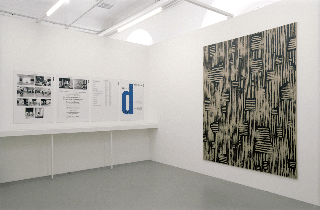
Fig.5
Archive in Motion, 2005, showing Friederike Feldmann, Happy Birthday 2005 (acrylic on canvas) referring to documenta 1
© The artist
Photograph: Nils Klinger
Compared to Discreet Energies, Archive in Motion was a very different type of exhibition riff: not as large, more obviously structured, and highly staged. It consisted of eleven small, interconnected, rhizome-like rooms in which Glasmeier employed two tropes to activatedocumenta memories, the memory palace and the archive.21 The formula for each of the rooms was the same. Each chamber contained two walls of archival documentation and two walls for a contemporary artwork based on the archive of that documenta (fig.5). Archival material consisted of panels with general information on responses from the public and the press, curatorial statements, and technical data.22 Five picture panels were used for documentary photographs. There were also clips from documentary films.23 Artists were allowed to use both the two other walls and the space within the rooms. In other words, the contemporary response was given equal or more space than the archival material. Artworks ranged from altered photographs (Kai Vöckler), to film loops (Jonathon Monk), to soundworks (William Engelen), sculptures (Heidi Specker), and installations (Andreas Seltzer and Heike Vogler). Most works were restrained on an emotion level but Sabine Gross’ Wertsteigerung (Increased Value), with its bright, dripping colour on the wall, spatial extensions and a free-standing, topless A.R. Penck cut-out, posing with arms and legs spread wide, captured the energy associated with documenta 5 (fig.6).
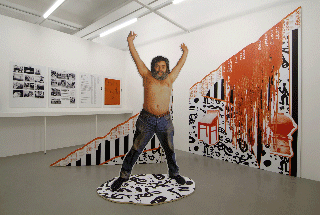
Fig.6
Archive in Motion 2005, showing Sabine Groß, Wertsteigerung (Increased Value) 2005 (digital print on PVC, protective foil, wood), referring to documenta 5
© The artist
Photograph: Nils Klinger
Glasmeier’s inspiration for the exhibition and its title comes from Aby Warburg’s mobile methodology for working with archives, as does Glasmeier’s use of montage in the picture panels for each documenta room. Warburg’s concept of history as a combination of archeology and the present also underlay Glasmeier’s strategy for disrupting a strictly chronological presentation within each room. Glasmeier’s categories were more circumscribed temporally, his layouts more geometric, and his images titled. Yet his use of Warburg’s concepts and structures was apparent to anyone familiar with Warburg’s writings and should be seen in the context of reassessments of Warburg’s work in recent art historical literature, notably Georges Didi-Huberman’s writings on Warburg.24 Glasmeier, like Warburg, constructed a visual argument attesting to the animation between past and present and vice versa; and like Warburg’s panels of multiple parts arranged on curved walls, Glasmeier’s thesis was displayed as a three-dimensional construct, haptically experienced as well as optically readable.
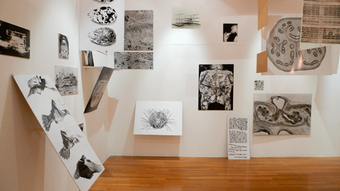
Fig.7
Retracing Exhibitions, curated by Kari Conte and Florence Ostende, Royal College of Art, London, March 2009
Flickr photograph © Hakan Topal
Retracing Exhibitions, a modest exhibition at the Royal College of Art, London, in March 2009, riffed on an exhibition reconstruction. It was an exhibition about exhibition legacies, the role of the fragment in memory, and ‘the difficulty of experiencing by-gone exhibitions in the present’.25 The curators, Kari Conte and Florence Ostende, produced a doubled remembering by including a section from Victoria Walsh’s 2001 full reconstruction of the 1953 Independent Group exhibition Parallel of Art and Life, included in the Nigel Henderson retrospective she curated in London (fig.7).26 The re-exhibited fragment was juxtaposed with works that ranged from Hans Haacke’s Photographic Notes for the 1959 documenta 2 to Pierre Leguillon’s 2009 Placement built of photographs he took in other artist’s exhibitions; from Joëlle Tuerlinckx’s installation of a fragment of one of her past exhibitions from her personal archive (Drawing Inventory, Drawing Center New York, 2006 – Chosen Extracts for Retracing Exhibitions 2009) to Benoît Broisat’s Black Boxes where video feeds of models of his recent exhibitions housed in closed transport crates played on screens. There was also an installation made from a selection of art critic Kim Levin’s archive of notes (1995–2004) and exhibition announcements (1975–91), as well as samples from Hans Ulrich Obrist’s archive of video interviews with artists, intellectuals and curators. Retracing Exhibitions pinpointed the desire to remember exhibitions by different players in the exhibition field, presented various forms of remembering, and posited the fragmentary nature of all such remembering.
The ‘remembering exhibition’ as reprise
But how did these ‘remembering exhibitions’ remember themselves? Publicly, primarily through massive catalogues with many essays and photographs. In other words, remembering took the form of tangible and traditional memory structures. All publications appeared in the language of the host institution as well as in English, in recognition of the need to disseminate the research as widely as possible. In addition, to a greater or lesser degree, post-2000 exhibitions also had an online presence to ensure visibility and provide information during the exhibition’s run and, thereafter, an ever-present archive of the exhibition event.
At this pivotal point in the history of the history of exhibitions and the history of the web, the relationship of the digital to the physical is key for determining what will be remembered. Yet the majority of institutions have yet to resolve how to documentise, let alone redocumentise,27 their archives online or create effective online forms that respond to the character and conditions of both the exhibition and the web.28 Instead, many institutions now post, and archive, basic exhibition information on their websites using a house-style design in a subcategory found under the exhibitions tab. Typically, the web user is given a few images of artworks and a rudimentary description, while installation shots are rare and videos even rarer (resources are often limited, copyright intervenes, and platforms change). When institutions and individuals do not mobilise the potential of the web as a remembering vehicle and space, the pattern of removing the history of exhibitions from active public memory and as a feature of everyday life is re-inscribed and archaic models for reprising exhibition history perpetuated.
Some curators and institutions, however, have embraced web representations of their ‘remembering exhibitions’ as integral components of their documentation and remembering processes. There is an increased understanding that reprising exhibitions on the web offers opportunities to record aspects of exhibitions that, until now, have remained invisible or under-visualised, to provide material not found in catalogues, and to circulate information about exhibitions before the catalogue is published or when out of print. An examination of the web presence for Glasmeier’s exhibitions and the Allan Kaprow Art as Life retrospective suggests the possibilities and limitations of reprising exhibitions on the web.
The web representations of Glasmeier’s documenta jubilee exhibitions are representative of ‘Web 1.0’ reprises. On the official archived documenta site, there is the usual, basic single-layer format, in this case four photographs (two artworks, two installation views) and a brief project description. However, on the Institute for Foreign Relations (IFA) website there is a more detailed re-presentation of Archive in Motion.29 IFA, which toured that exhibition, used its website as both press release and exhibition brochure. The introductory page, with its juxtapositional design, echoes the past/present amalgam format of the actual exhibition through two parallel strips of images separated by a descriptive text. Activating each photograph of a contemporary artwork led to detailed information on the piece, with the possibility of a further link to more information on the artist. Activating an archival photograph resulted in only an enlargement and no information whatsoever. The archival material became a mystery while the contemporary installations were presented as history, surely the opposite of Glasmeier’s curatorial intent.
The IFA site does not mention Archive in Motion’s history as one part of an exhibition pair, nor does it include any information about tour venues in Europe and Asia.30 A Google search turned up information about the creation of an exhibition at the National Museum of Singapore to accompany Archive in Motion. Picturing Singapore 1955–2005: An Archival Perspective, which was designed as a site-specific response to an import, a way of bridging the gap between two very different histories and visual cultures. The webpage from the popular information source ‘Singapore Sights’ describing the event highlighted this discrepancy, by asking pointedly ‘How are the two related?’31 The omission of Picturing Singapore from all the institutional websites associated with Archive in Motion (Fridericianum, IFA or the National Museum of Singapore) re-inscribes a pattern of first-world cultural hegemony and erases substantial attempts at repositioning Eurocentrism. The omission of any mention of the tour also points to an absence in exhibition histories, where documentation of travelling exhibitions is almost non-existent. The resulting spatio-temporal reduction erases the widespread and longer-lasting effects of an exhibition that travels and eliminates the possibility of detailed assessments of the travelling exhibition from exhibition typologies and histories.
By contrast, the website for Allan Kaprow: Art as Life 32 does give an integrated overview of the four venues of the European tour. This meta-site, conceived by Eva Meyer-Hermann and Stephanie Rosenthal, curators of the exhibition, was designed to address lacunae in the catalogue and disseminate information during and after the exhibitions. Each museum provided information about the other venues as well as its own, and extensive documentation. Giving equal valence to all the museums recognises that the venues of an exhibition are integral to its history. The design of the meta-site may be rudimentary, but its very existence is unprecedented.
Art as Life also travelled to the Los Angeles Museum of Contemporary Art. MOCA’s now archived website contains a wealth of material.33 Like the kaprow.org introductory page, the overall schema of the website and its link to the exhibition’s components is immediately visible, with a ‘snap-to-grid’ set of twenty-nine images, one per happening, and various sub-categories. Unlike many snap-to-grid rectangles that use a digital feature to automatically arrange various sizes and shapes of photographs in similarly-sized units, the MOCA grid is layered. Each venue recorded its happening according to means and inclination, but for all of them there is the possibility for individual web users to comment, an interactive feature in keeping with Kaprow’s participatory philosophy of art. There is a place to click for a definition of a happening and a link to the kaprow.org site. Returning to the introductory page, the web user can enter a window that leads to installation photographs of walls of Kaprow’s paintings and installation views of recreated environments in the MOCA exhibition, each with succinct and precise information about the current and original manifestation. There is also a window leading to images and information on Trade Talk, based on Kaprow’s 1988 Trading Dirt, here designed to elicit comments and reflections by past and more recent participants in Kaprow’s works.
The form of MOCA’s site for the Kaprow exhibition departs from MOCA’s house-style for exhibition web pages. MOCA understood that the Kaprow retrospective was a landmark exhibition and needed to be remembered as such. The exhibition was the first time his happenings and environments had been recreated, reinvented, or revisited in such great numbers and there was an urgency to finding an adequate vehicle for remembering this multi-site ‘remembering exhibition’. In every component of the web pages, the distinction between past and present is evident, as is the desire to construct a living legacy. The mix of bright and muted colours of the website, its many sections but crisp design and multi-layering, produce the effect of bringing the past into the present. MOCA’s online reprise re-presents the Kaprow exhibition in a form that echoes both the newness of Kaprow’s art when he first presented it and Kaprow’s aesthetics of intangibility and participation.
The documentation of the multi-site Fluids (1967/2008) is the fullest attempt to reprise a happening on the MOCA website and a good example of various new possibilities for remembering exhibitions online. Fluids was a one-day happening that involved building a rectangular structure of ice blocks, then leaving it to melt away (hence its title). On the website, the information consists of a list of the ten venues where Fluids was recreated, an historic photograph, a poster, a description, as well as two photo-grids and a video, also posted on YouTube, which give a sense of the event’s temporality. The photo-grids allow viewers to follow sequentially the processes of construction (the installation of the ice blocks) and disintegration (the melting of the built configuration) while, simultaneously, viewers apprehended the temporality of the happening in a single moment. The photo-grids also record the re-invention of Fluids in two geographic locations in the same web space, making the simultaneity of the same event, invisible in actuality, visible virtually. The multi-modal forms of remembering Art as Life online can be read as a visual equivalent for the malleability of memory and the many means we use to shape it.
The curators of Retracing Exhibitions at the Royal College of Art, Kari Conte and Florence Ostende, also used the web to convey usually invisible aspects of exhibitions. A four-page ‘snap-to-grid’ sequence of 211 photographs on Flickr documents the process of installing the exhibition at the RCA and the exhibition’s opening.34 ‘Snap-to-grid’ formats often freeze and isolate images but here the abundance of photographs, many obviously taken seconds apart, conveys both the duration and the organic evolution of actual and ideational flow (with some of the photographs showing the curators thinking). Shifts between black-and-white photographs, used for shots depicting the installation of works in the show and the opening, and colour for photographs of the works in situ, are used to capture and convey fleeting and fixed exhibition moments. The photographs are also available as a slide show on Flickr, with a ribbon of smaller images running below the full screen slide on the screen. The timed changes between slides also suggest sequencing and flow. The curators represented different exhibition times by curating multiple web spaces: the less formal, shared online community platform, Flickr, to document the process of filling an empty space with art and people, and the more formal institutional RCA site to document the artwork and the seemingly static time of the exhibition space. The animated slideshow next to the static text on the exhibition’s homepage gave viewers a sense of the varied nature of the exhibition and how it morphed depending on viewpoint and moment. The changing images also conveyed the sense of the exhibition as an evolving, dynamic entity, both for curators and viewers, rather than a collection of isolated, static fragments. As well as surface shifts, the curators provided layered information on each of the artists- with close-ups and zooms, the in-depth looking suggesting different strata of information.
By contrast, the Centre Pompidou website for Voids was notably understated. There were no installation photographs and no videos. Even the colour was muted, almost monochromatic.35 The minimalism of the site, however, fitted the theme of the exhibition and acknowledged the availability of multiple, non-institutional, online resources for images and information for remembering exhibitions. Official, copyrighted colour installation photographs of Voids, in fact, are easily available with a Google Image search, indicating that they exist and have been used in other contexts.36
Aynur Méric’s non-official video provides a different record of the look of Voids in comparison to the coloured web documentation and the catalogue where photographs appear only in black and white.37 Méric experiments with camera position, zooming in and out, sometimes very quickly, or rotating the camera so that ceiling and floor views are privileged. He constructs a fuller, if less hagiographic, record of the rhythms and realities of seeing exhibitions and attempts to determine what they are about. His tracking video allows screen viewers to identify with exhibition viewers and when, using the full screen option, to become absorbed like them in the viewing process. Méric’s video includes sound: ambient sound, the background sounds of walking in exhibitions, and the voices of visitors. Shattering the silence of traditional photographic modes of remembering exhibitions signals a desire to remember bodies as well as artworks in exhibition spaces, to construct a more corporeal, less abstract portrayal of the contemporary exhibition viewing experience. Whether or not people are shown, non-fixed cameras presuppose the body in the exhibition space in ways that fixed cameras or traditional installation photographs do not.
YouTube, in particular, has revolutionised what is publicly remembered about exhibitions with material not found on museum websites such as videos of vernissages where the focus is as much on those attending as the art, videos taken clandestinely in exhibitions by individuals, or the addition of a soundtrack or commentary. Personalised responses, such as Méric’s, add new dimensions to reception history and its links to memory. Moreover, individuals who record, interpret and post their own exhibition experiences on shared sites have become acknowledged contributors to contemporary modes of producing and disseminating knowledge.
The pressure of so much individual remembering has pushed institutions to adopt and adapt to the newest forms of online remembering. Institutions that ‘share’ images and videos by archiving, posting or branding on multiple sites appear less autonomous and proprietary. As an example of an alternative to populist responses to the web, LACMA’s Art of Two Germanys online emphasises pedagogy and professionalism: 38 in addition to the usual descriptive information, there are links to a slideshow of installation photographs (a feature unseen before digital cameras and the proliferation of easily uploadable images), a timeline situating the art politically (an acknowledgement of the need for context and shared knowledge), and a video interview with the curator in the exhibition space (a hybrid combining personal response and traditional museum education). The video is also available on ArtBabble.org, a consortium museum site, showing high-definition, high-quality art videos, developed by Maxwell Anderson, Director of the Indianapolis Museum of Art and a leader in web use for and by museums. Many of the transcripts are searchable on Google or locally allowing for exact segments to be found.39 The facility with which images and videos can migrate from site to site, their inclusion in general web searches, and their downloadability increase the likelihood they will be seen – and remembered. And the more exhibitions rather than artworks in exhibitions are seen, the more possible a wider and fuller understanding of exhibition histories becomes.
Addendum
These following statements are designed to open the essay onto a consideration of the meta-archive, make connections with earlier art-historical methodologies with similar orientations, and counter some of the usual objections about ‘webification’.
- The problems with using the web to reprise exhibitions – the risk of feeding the exhibition as spectacle syndrome, the lack of any information about the artworks in individual videos and postings, the imbalance in what gets recorded and how for example – do not, to my mind, outweigh the many advantages, including the greater possibility of colour images, the quantity of available documentation and, for the first time, the sounds of various moments in an exhibition’s history. Typographic media restrict this kind of information.
- If reprising exhibitions on the web increases the amount of exhibition material and disseminates it more widely, it also collapses traditional notions of exhibition time and space. Past and future exhibitions re-presented on the web become a simultaneous present, while geographically distant exhibitions become proximate and available for scrutiny.
- With so much material available online, there is a need for meta-site shared archival commons. Consortiums like Artbabble, transzit, museumashub point to a trend in this direction. Without the contribution of institutions and individuals to such sites, writing histories of exhibitions will be limited in form and content. Earlier art historians such as Malraux and Warburg understood the desirability of a myriad of material and flexibility in arranging and re-arranging it as a methodological tool. Their processes are being updated and extended by fully utilising the possibilities of reprising exhibitions on the web and incorporating material from more than one author. Meta-sites reprising exhibitions have the potential to de-centre and augment existing exhibition histories, not only by making more exhibitions visible but by ensuring their place in history.
- Developing the technologies of remembering exhibitions may be the best way to establish what Communication Studies scholar Lorna Roth calls ‘cognitive equity’: a state where stereotypes, however unconscious, have been eliminated from the moment of inscription, so that they are no longer repeated.40
- The statement by sociologist Zigmunt Bauman cited in the press release for the exhibitionAfterlife of Buildings, at the Polish Pavilion in the 2008 Venice Architecture Biennale, describes the mindset needed in the transitions from monographic to multimodal and meta-responses to remembering history: ‘It is only what’s fluid, continuously reborn and redefined that stands a chance of surviving in the liquid reality.’

